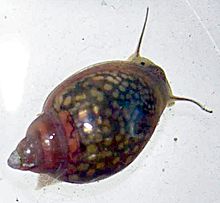Physidae
| Physidae | |
|---|---|
 |
|
| A live individual of Physella acuta from the Mediterranean area | |
| Scientific classification | |
| Kingdom: | Animalia |
| Phylum: | Mollusca |
| Class: | Gastropoda |
| (unranked): | clade Heterobranchia clade Euthyneura clade Panpulmonata clade Hygrophila |
| Superfamily: | Planorboidea |
| Family: |
Physidae Fitzinger, 1833 |
| Diversity | |
| About 80 freshwater species | |
Physidae, common name the bladder snails, is a monophyletic taxonomic family of small air-breathing freshwater snails, aquatic pulmonate gastropod molluscs in the clade Hygrophila.
These fresh water snails are present in aquariums and ponds, as well as in wild areas. They are commonly referred to as tadpole snails or pouch snails. They eat algae, diatoms and detritus including dead leaves. The populations are regulated by the abundance of food and space. They are widespread, abundant, and tolerant of pollution.
These snails are common in the North Temperate to Arctic Zones and throughout the Americas, in readily accessible habitats such as ditches, ponds, lakes, small streams, and rivers. The family has been recognized since the 19th century, and yet there has been no classification in which relationships between genera are clarified, no agreement on what characters are primitive or advanced, and no consistent ranking. Scarcity of careful morphological studies is the principal cause. The differences in the group have led to the creation of more than 23 genera, four grades and four clades within the family. The two established subfamilies are divided into seven new tribes including 11 new genera. Within this family, the shell is always sinistral, in other words it has left-handed coiling. Physidae has 23 genera, 17 occur in Pacific drainages of North and Central America, eight of these restricted to the region. Concentration of primitive genera along the Pacific coast from Mexico to Costa Rica conforms to previous observations that primitive pulmonate families are concentrated within, or along the continental margins of, the Pacific Ocean. An ancestral origin of Physidae along an ancient eastern Pacific coast is probable. From this region the several lineages have spread to north, south and east in the Americas, and through Siberia to Europe.
...
Wikipedia
